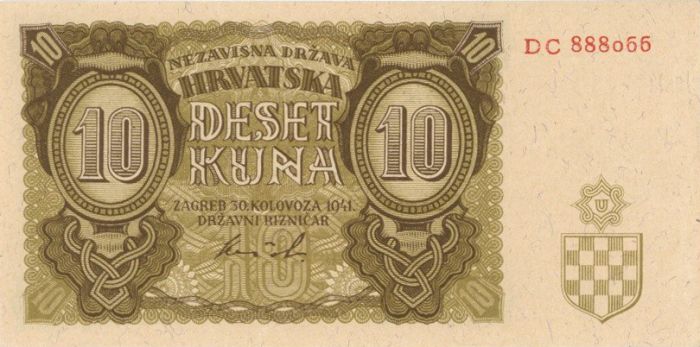Croatia - P-5b - Croatian Kuna - Foreign Paper Money
Inv# FM2442 Foreign Paper Money
10 Kuna, P-5b.
The kuna is the currency of Croatia, in use since 1994 (sign: kn; code: HRK). It is subdivided into 100 lipa. The kuna is issued by the Croatian National Bank and the coins are minted by the Croatian Monetary Institute. The plural form of the word kuna in Croatian can be kuna or kune (e.g. 2 kune, 10 kuna) because of different number declension rules. 2022 will be the final year for the kuna as Croatia is scheduled to replace it with the euro (€, EUR) on 1 January 2023. All Croatian bank accounts and credit cards will automatically be converted to euros and kuna cash may be exchanged for euros at no charge.
The word kuna means "marten" in Croatian, referring to the historical use of marten pelts as units of value in medieval trading. The word lipa means "linden (lime) tree", a species that was traditionally planted around marketplaces in Croatia and other lands under Habsburg Monarchy rule during the early modern period.
During Roman times, in the provinces of upper and lower Pannonia (today Hungary and Slavonia), taxes were collected in the then highly valued marten skins. Hence the Croatian word marturina ("tax"), which derived from the Medieval Latin word for "marten" martus, which came from Proto-Germanic *marþuz through Old Dutch and Old French (modern Croatian for "marten": kuna). The kuna was a currency unit in several Slavic states, most notably Kievan Rus and its successors until the early 15th century. It was equal to 1⁄25 (later 1⁄50) gryvna of silver. The plural form of kuna in Croatian is kune.
It has no relation to the various Slavic currencies named "koruna" (translated as kruna in Croatian) which means "crown".
In the Middle Ages, many foreign monies were used in Croatia, but since at least 1018 a local currency was in use. Between 1260 and 1380, Croatian Viceroys issued a marten-adorned silver coin called the banovac. However, the diminishing autonomy of Croatia within the Croatian-Hungarian Kingdom led to the gradual disappearance of that currency in the 14th century.
The idea of a kuna currency reappeared in 1939 when Banovina of Croatia, an autonomous province established within Kingdom of Yugoslavia, planned to issue its own money, along with the Yugoslav dinar. In 1941, when the Ustaše regime formed the Independent State of Croatia, they introduced the Independent State of Croatia kuna. This currency remained in circulation until 1945, when it – along with competing issues by the communist Partisans – disappeared with the establishment of FPR Yugoslavia and was replaced by the Yugoslav dinar.










Ebay ID: labarre_galleries